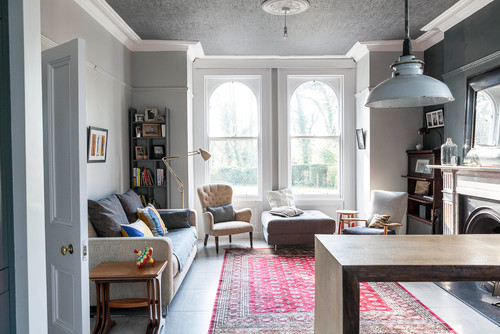HomeWorld’s annual Generational Marketing Report in the August 6 issue examines how the downsizing of American homes across generations is reshaping housewares design, development and marketing.
Among the indicators of this small space living and design convergence is escalating demand for and creation of space-conserving, multi-functional and convertible housewares— from countertop cooking appliances to task furniture to tableware.
This year’s report looks at overall housing trends influencing the market; and how small space living is impacting design trends in home goods.
NEW YORK— The small space living trend has been hailed by the industry as the Millennial/Baby Boomer tie that binds. One is aging into homeownership looking for starter homes and access to urban markets while the other is experiencing “empty nesting” and looking to downsize.
This small space living trend has impacted product development across a number of housewares categories, and trends within the housing market over the past two years have pointed towards an uptick in smaller housing after years of decline.
According to the Census Bureau, new single-family houses less than 1,400 square feet that were sold in 2017 rose from 17,000 to 21,000. In addition, single-family homes between 1,400 and 1,799 square feet that were sold in 2017 rose from 79,000 to 90,000.
Rose Quint, avp/survey research at the National Association of Home Builders, added that about 12% of single-family starts in the last year and a half are townhouses.
“The share of townhouses declined substantially during the recession, but it has come back up because they are a good bridge between renting and buying. That is part of the reason that the overall average home size has declined over the last two years, because we see more construction of these kinds of homes,” she told HOMEWORLD BUSINESS®.
However, while demand for smaller spaces is on the rise, housing trends have revealed somewhat unexpected demographic preferences within that market.
Millennials remain a powerhouse in terms of buying potential within the housing market due to their sheer size and age range, but the group overall has not settled into smaller apartments and the urban centers that build them as readily as was previously expected.
“We are seeing that Millennials and first time homebuyers are actually both being pushed to the suburbs because they offer more affordable properties. We do see first time home buyers are typically purchasing a single family detached home. It might be a little smaller, but it is a very traditional home,” said Jessica Lautz, director of demographics and behavioral insights, National Association of Realtors.
According to market research firm The AIMsights Group, 54% of all buyers purchase homes in the suburbs. Of those, 57% are Millennials, ages 36 and younger.
“The stereotype of Millennials as urban hipsters does not match up when it comes to home ownership and this new life stage,” said Marsha Everton, principle, The AIMsights Group.
When it comes to Millennials, a number of factors have impacted housing purchases and preferences. Affordability, for example, for this demographic is the name of the game, Lautz said, and has impacted the group’s ability to purchase high-priced urban housing.
Some experts have also noted that Millennial homebuyers, many aged over 30, may be looking to have children in the near future. Millennial first-time homebuyers would be remiss not to consider more traditional suburban housing that could accommodate a larger household a few years down the road at a similar or even lower pricepoint than urban housing offers.
At the same time, Baby Boomers are also disproving assumptions made of them within the housing market. According to Everton, this group is showing more enthusiasm for “aging in place” rather than selling suburban homes and moving into urban communities.
“They look at downsizing, but the costs are more than they want to pay, particularly when it comes to cash flow,” Everton said.
While 15% of Millennials and 15% of Generation X are purchasing in urban centers, Lautz noted that the Silent Generation, ages 72 to 92, are in fact the demographic to watch. “What I find interesting is that the oldest generation is purchasing single-family detached homes at lower rates and they are purchasing condos and townhouses at higher rates. They want a smaller space and are not wanting the upkeep of a larger home,” she said.
However, while these demographics may not be purchasing the apartments expected of them, purchases of smaller single-family homes still open up opportunities for the industry where renovations can be a key instigator for housewares purchases.
According to Everton, 42% of all homebuyers are Millennials, 31% of homebuyers are Generation X and Baby Boomers account for 16% of homebuyers. And, homebuyers are also home renovators, with 73% of buyers renovating.
“And we make purchases of items that work and fit in our renovated space,” she said.
Another key change in the housing market that could have positive implications for the housewares industry is the growth of U.S. households over rental demand.
According to the Joint Center For Housing Studies at Harvard (JCHS), after a decade of soaring rental demand, growth in the number of renter households slowed from 850,000 annually on average in 2005 to 2015 to just 220,000 in 2015 to 2017. And, the number of owner households rose 710,000 annually on average in the past two years.
As renters become homeowners, an opportunity for the industry arises. Most consumers are more inclined to purchase housewares when they feel their surroundings are permanent. In addition, new homeowners are more likely to be gifted a wide range of housewares for the home and kitchen.
When it comes to designing housewares for smaller spaces regardless of housing type, the Millennial and Baby Boomer generations currently lead household growth, and are two of the current generations to watch especially as their housing preferences continue to evolve.
Read full article here at Home World Business

























 Lofty Starridge condos capture views from their Portland Heights perch
Lofty Starridge condos capture views from their Portland Heights perch

